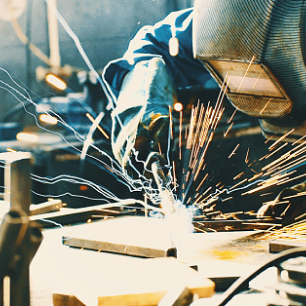Jump to:
How to Weld Aluminum: Techniques, Tools, and Safety Tips
Learn how to tackle aluminum welding with confidence—no magic tricks required.
Welding aluminum is like cooking on high heat with a delicate pan—fast, precise, and not very forgiving—especially for beginners. It’s finicky, fast-cooling, and a little less forgiving than steel. But with the right tools, techniques, and a few key tips, you'll be surprised at how manageable (and satisfying) it really is.
In this guide, we’ll break down how to weld aluminum using beginner-friendly approaches like gas tungsten arc welding (GTAW, also known as TIG) and gas metal arc welding (GMAW, also known as MIG). We'll also cover what you need to get started, how to stay safe, and how to build the skills that’ll help you move from awkward practice beads to clean, confident welds.
Why Welding Aluminum Feels Different
Aluminum is lightweight, corrosion-resistant, and widely used in industries ranging from aerospace to auto repair. But its high thermal conductivity and oxide layer make it a bit of a challenge—especially if you’re used to mild steel.
Understanding these quirks up front can make a big difference. And trust us: learning how to weld aluminum doesn’t require superpowers—just good prep and practice.
What You Need to Weld Aluminum
Before you strike an arc, here’s what’s essential:
- A capable welding machine: For GTAW, look for an AC-capable machine. For GMAW, you’ll need a spool gun or push-pull system to feed soft aluminum wire without snarls.
- 100% Argon shielding gas: Aluminum needs a clean, inert atmosphere—no mixes.
- Clean material: Aluminum’s oxide layer melts at a higher temp than the base metal. Use a stainless steel wire brush or a chemical etchant to clean surfaces before welding.
- Safety gear: Think helmet, gloves, flame-resistant clothing—and good ventilation. Aluminum welding can produce ozone and other fumes.
Explore AWS education resources for training options that’ll get you up to speed faster.
GMAW vs. GTAW: What’s the Best Way to Weld Aluminum?
Both methods work—here’s how to decide:
GMAW Welding Aluminum
- Faster and easier for beginners
- Ideal for thicker material (⅛” or more)
- Great for production or repair work
- Use a spool gun to feed wire smoothly
GTAW Welding Aluminum
- Clean, precise welds
- Ideal for thin material and delicate work
- Requires more control and coordination
- Best choice for projects where aesthetics matter
Want a side-by-side breakdown? Check out Lincoln Electric’s guide to aluminum welding.
Step-by-Step: How to Weld Aluminum
1. Prepare the Material
- Brush off oxide using a dedicated stainless wire brush.
- Clean with acetone to remove grease and moisture.
2. Set Your Machine
- For GTAW: Use AC polarity, high-frequency start, and adjust balance for oxide cleaning.
- For GMAW: Set voltage and wire feed speed according to the wire diameter and material thickness.
3. Practice Your Technique
- GTAW: Maintain a tight arc, keep your filler rod in the leading edge of the puddle, and go slow.
- GMAW: Push the torch (don’t drag), maintain a steady travel speed, and watch for burn-through.
4. Watch Your Weld Pool
- Aluminum weld pools are shiny and can be hard to read at first. Look for a stable, flowing puddle—like mercury moving in slow motion.
Safety Tips for Welding Aluminum
Aluminum welding comes with specific safety needs:
- Ventilation is critical. Fumes can contain ozone and nitrogen oxides.
- Wear proper eye protection. AC GTAW can cause high-frequency flashes.
- Avoid welding near flammables. Aluminum projects often involve thin sheet or tubing—keep the area clear.
AWS offers guidance through its standards and publications to keep you welding safely and effectively.
Final Thoughts
Welding aluminum opens up an entirely new range of possibilities—from bike frames and toolboxes to auto bodywork and artistic projects. Whether you're tackling your first bead or refining your GTAW technique, the best way to get better is to keep striking arcs and learning from every pass.
Learn more about AWS Membership to connect with fellow welders and access exclusive resources.
FAQs About Aluminum Welding
Q: What kind of welding is used for aluminum?
A: GTAW and GMAW are the most common. GTAW is precise, GMAW is faster.
Q: Can you weld aluminum with a normal welder?
A: Not really — most entry-level welders aren’t AC-capable or equipped for aluminum wire feeding.
Q: Can I weld aluminum at home?
A: Yes, with the right gear and setup. Just be sure to have good ventilation and follow safety guidelines.
Q: Is aluminum difficult to weld?
A: It has a learning curve—but once you get the hang of the heat control, it’s totally doable.
Q: What is the trick to welding aluminum?
A: Clean prep, tight arc control, and the right filler material. Also: patience.
Q: Is brazing aluminum as strong as welding?
A: Not quite—brazing is easier but doesn’t match the structural strength of a good weld.


